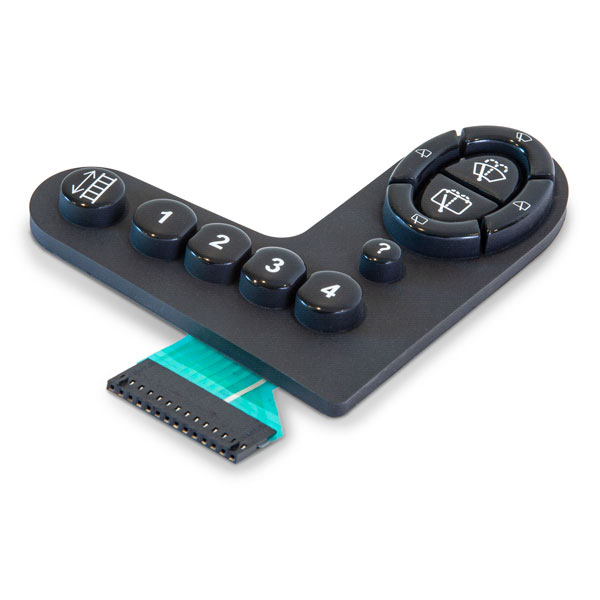Membrane Switch: A Comprehensive Guide to Its Uses and Applications
Understanding Membrane Changes: The Key to Trusted and resilient Controls

What Are Membrane Layer Buttons?
Membrane layer switches are a sophisticated service in the world of interface modern technology, combining functionality and design perfectly. These tools act as a user interface in between customers and digital systems, incorporating several components into a compact style. Normally created from flexible, thin layers of materials, membrane switches are developed to reply to touch, allowing users to communicate with machinery and electronic devices efficiently.
The primary elements of a membrane layer button consist of a published circuit layer, graphic overlay, and a spacer layer that avoids unintentional activation. The graphic overlay can be customized to reflect brand name identification or individual preferences, enhancing aesthetic appeals while guaranteeing use. Membrane switches are commonly made use of in numerous applications, consisting of clinical gadgets, consumer electronic devices, and commercial devices, owing to their sturdiness and resistance to environmental factors such as dampness and dirt.
One of the vital benefits of membrane buttons is their capacity to stand up to deterioration, making them perfect for high-traffic atmospheres. In addition, they are light-weight and need marginal area, permitting cutting-edge styles in product growth. In general, membrane layer changes represent a reliable and functional choice for contemporary electronic user interfaces, marrying innovation with user-centric design concepts.
Just How Membrane Switches Over Work
The procedure of membrane layer switches hinges on a basic yet effective mechanism that equates customer input right into electronic signals. When an individual presses the switch, the leading layer flaws, allowing a conductive element in the circuit layer to make contact with a matching conductive pad on the bottom of the visuals overlay.
The layout of membrane switches can vary, but they commonly include domes or responsive elements to provide comments to the individual, improving the general experience - membrane switch. The products made use of in membrane layer buttons, such as polyester or polycarbonate, add to their durability and resistance to environmental elements, including wetness and dust. Moreover, the published circuits are normally enveloped, which shields them from damage gradually.
Benefits of Membrane Layer Buttons

Additionally, membrane switches are understood for their longevity. Created from durable products, they are immune to dust, moisture, and physical wear, which significantly extends their life expectancy compared to conventional mechanical switches. This toughness makes them specifically ideal for high-traffic settings and applications calling for long life.
One more considerable advantage is the simplicity of cleaning and maintenance. The smooth surface of membrane switches over decreases dirt build-up and is commonly resistant to spills, making them suitable for setups that need frequent sanitization.
Moreover, membrane layer buttons use a streamlined profile, leading to a thinner layout that can be incorporated into various devices without including bulk. This feature not just boosts the aesthetic appeal yet additionally adds to a more ergonomic item style.
Applications of Membrane Buttons
Flexible Clicking Here and easy to use, membrane buttons discover applications across a wide variety of markets, consisting of medical devices, customer electronics, and commercial devices. In the clinical area, these switches are indispensable to tools such as analysis equipment, client surveillance systems, and infusion pumps, where reliability and convenience of cleaning are essential. Their capability to maintain and hold up against severe settings functionality makes them excellent for such applications.

In consumer electronics, membrane layer switches are utilized in items like microwaves, cleaning devices, and remotes - membrane switch. Their sleek style enables intuitive individual interfaces, boosting the total user experience while supplying toughness and resistance to tear and use
Commercial tools also benefits from membrane buttons, specifically in control panels for machinery and automation systems. These switches provide security versus dirt and moisture, guaranteeing constant efficiency in tough settings. Furthermore, their adjustable functions permit suppliers to customize them to specific operational needs, enhancing effectiveness and performance.
Picking the Right Membrane Layer Switch Over
When picking a membrane layer button, it is vital to think about different elements that influence performance dig this and viability for details applications. The key factors to consider include environmental conditions, responsive responses, toughness, and style specs.
First, assess the operating environment; buttons subjected to moisture, chemicals, or extreme temperature levels need particular materials to make certain durability and functionality. Next, review the requirement for tactile responses. Depending upon user communication, some applications might take advantage of a responsive feedback to validate activation, while others may choose a non-tactile design for visual reasons.
Sturdiness is another essential aspect; membrane buttons ought to be designed to stand up to frequent usage, effects, and abrasion. Ensure the picked switch can sustain the expected lifecycle, specifically in high-usage situations.

Conclusion
In verdict, membrane layer switches offer as essential elements in the layout of reliable and resilient control systems throughout numerous industries. The flexibility of membrane layer switches over permits for tailored services that satisfy details functional needs, reinforcing their relevance in modern-day innovation.
Membrane layer switches represent a vital element of contemporary user interface layout, mixing capability with resilience in various applications.Membrane switches are a sophisticated service in the realm of individual interface innovation, integrating performance and style effortlessly. Commonly created from adaptable, slim layers of products, membrane layer buttons are created to react to touch, allowing individuals to communicate with machinery and electronic tools successfully.
The layout of membrane layer buttons can differ, yet they usually include domes or responsive components to supply comments to the individual, enhancing the overall experience.In conclusion, membrane layer changes serve as important components in the design of sturdy and trusted control systems throughout various industries.